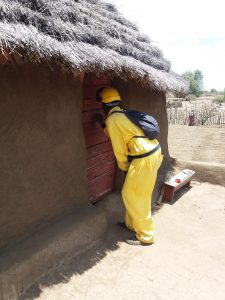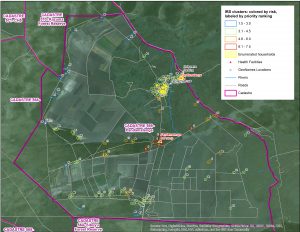Six countries in southern Africa – Botswana, Mozambique, Namibia, South Africa, Swaziland and Zimbabwe – are on the path towards malaria elimination, having declared their goal to achieve zero locally acquired malaria cases by 2020. The population at risk of the devastating illness in these countries has declined dramatically in recent years, with cases in the four ‘frontline’ countries – Botswana, Namibia, South Africa, and Swaziland – decreasing from 71,000 in 2010 to 22,000 in 2015– a 69% reduction.
These successes are attributable to increased international donor and domestic funding, strong political commitment and collaboration, and the availability and use of effective interventions. Such interventions include rapid diagnostic tests that allow healthcare workers to test for malaria at the point of care (without the need for a laboratory), highly effective drugs such as artemisinin-based combination therapies, and proven vector control tools such as indoor residual spraying (IRS) and long-lasting insecticide-treated nets (LLINs).
Despite progress, gains are fragile and deliberate efforts are required to more efficiently deliver interventions to the right places at the right times. Achieving the ambitious yet attainable goal of malaria elimination in the region by 2020 will require that programs begin accelerating their efforts now, targeting interventions with increasing precision while striving for ever higher performance and outcomes.
The parasite responsible for causing malaria in southern Africa (Plasmodium falciparum) is transmitted from person-to-person by mosquitoes. Thus, interventions that target mosquitoes have served as the cornerstone of many malaria programs. These public health measures include IRS, which involves spraying insecticide on the inside walls of houses in order to kill the mosquito when it rests on the wall. IRS is particularly effective in areas where the mosquitoes tend to rest and bite indoors and where communities spend their time indoors during dusk, night, and dawn when mosquitoes prefer to feed.

IRS Spraying
Countries in southern Africa have been implementing IRS for over 50 years in the form of routine, yearly campaigns conducted just before the onset of the malaria season and/or as a reactive strategy in response to malaria outbreaks. IRS requires spray teams to travel to at-risk communities which may be remote and difficult to reach to spray the walls of structures with protective insecticides. Operations tend to be expensive and resource intensive.
With limited funding and human resources, as well as constant challenges with transport and other logistical constraints, detailed planning is required to ensure that countries obtain the “biggest bang for their IRS buck” – in other words, to effectively achieve the greatest reduction on malaria transmission with the funding and personnel that are available for implementing IRS programs.
Yet, up until now, countries have not had accurate data or mapping tools to identify exactly which specific areas to spray, instead relying on local knowledge and estimates. This has led to both shortages and costly over-estimates on insecticide orders, and inefficiencies when coordinating operations in the field. They have also relied on paper forms for data collection during IRS campaigns, which has delayed key analyses and restricted quick decision-making for improved operations.
CHAI has been supporting programs in Botswana, Namibia, Swaziland, and Zimbabwe to harness the power of digital technology to increase the impact of their IRS programs. Working closely with partners such as Akros and Humanitarian OpenStreetMap, CHAI supported national malaria control programs to remotely build detailed household footprint data, based on freely available satellite imagery, in order to better estimate and map target populations for IRS. By analyzing these data, together with patient data from health facilities, CHAI helps programs prioritize clusters of houses in each country where IRS would be of greatest impact.

These innovative approaches allowed CHAI to provide spray teams with simple tables and easy-to-read maps of the most critical locations prior to any field implementation of IRS. To improve data quality and enable data-driven decision-making during field operations, CHAI also supported the design and development of user-friendly electronic data collection tools and web-based dashboards. These tools allowed teams to visualize key indicators such as team progress and coverage in the form of summary tables, customized charts and context-specific maps. They also provided a breakdown of the reasons why some people refused the intervention (e.g., not wanting to get their walls stained) in order to better inform and mobilize education campaigns.
For the 2016/2017 spray season, all four countries used the detailed household footprints and associated maps to more precisely target their IRS efforts than they had ever done before. Countries also used electronic data collection and dashboards to inform operations throughout the spray season. Moving forward, CHAI will support increased use of these tools to maximize the impact of this novel approach for improving IRS operations to help countries advance towards malaria elimination.





